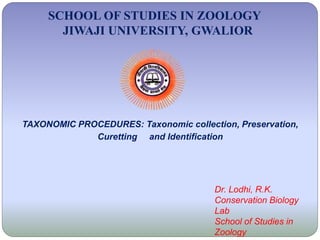
TAXONOMIC PROCEDURES.pptx
- 1. SCHOOL OF STUDIES IN ZOOLOGY JIWAJI UNIVERSITY, GWALIOR Dr. Lodhi, R.K. Conservation Biology Lab School of Studies in Zoology TAXONOMIC PROCEDURES: Taxonomic collection, Preservation, Curetting and Identification
- 2. Synopsis Introduction of Taxonomy Taxonomic procedures Collection Preservation of collected material Curetting Identification Conclusion References
- 3. Introduction Taxonomy is a science of classification of organisms i.e. biological classification. The term taxonomy is derived from the Greek word taxis which means ‘arrangement’ and nomo's which means ‘law’. Therefore, taxonomy is the principle of systematic zoology and botany and sets up arrangements of the different types of organisms (plants and animals) in their hierarchical order. Taxonomy term was coined by Condelle (1817) According to Ernst Mayr (1982):“Taxonomy is the theory and practice of classifying organisms”
- 4. Taxonomic procedures Taxonomy deals with in collection of individuals, organisms, which includes the classification, Identification, proper preservation, publication etc. Taxonomic collection involves four major and important steps. Which are: 1) Collection 2) Preservation 3) Curetting 4) Identification
- 5. Collection Collection of specimen is the foremost but different task for a taxonomist. It deals with the collection of specimens from different areas. The collection can either be borrowed from the museum, institutions or collected by specialist by himself. There are various collecting methods to collect animals. Various equipment's are employed for collection e.g. nets for birds and fish collecting, ultra violet lamps for insect collecting.
- 6. Techniques of Animal Collection Catching by hand. Netting : Frogs, fishes etc. Digging and draining : Most of burrowing animals like Amphioxus, can be collected by digging and draining. Shooting : Specimens like snakes, birds fast running rodents and carnivorous mammals collected by shooting with a small gun or pistil.
- 7. 1) Nets for birds 3) Fish collecting nets Cont…… 2) Malaise trap 4) Aspirator
- 8. Cont…. 5) Beating method 6) Sweeping 7) Burlese funnel 8) Insect killing jars
- 9. Preservation of collected material The method of preservation varies from group to group. The specimens are preserved in such a way that they are not destroyed, either through the action of insect pests, mold, oxidation, dying out, protein decay. It is essential for the collection to know in advance the various technique as already in use for the group. The chemicals or preservatives used for preservation of specimens are as: Formalin, Acetic acid,DDT ,and Carbon disulphide
- 10. Types of preservation Dry preservation: Mostly birds and small rodents are preserved after drying them . Wet preservation : The preservation of animals in formalin or 90% alcohol is called as wet preservation
- 11. Curetting This method involves the assembling, managing and presenting same type of collection over a long period of time. Once the animals are collected, labeled and preserved, the next job is of their safe custody, cataloguing etc. A curator knows the function of his collection the groups of animals in which collection are needed areas which need to be urgently sampled. Curators primary responsibility is to preserve the collection to maintain and conserve a documented record of his collection.
- 12. Identification The purpose of identification is basically to determine what kind of organism a given specimen is. Organism are identified on the basis of species level. All the Information concerning the morphology, an organism are essential for classifying and identifying. After the animals are collected they are first stored out and are identified up-to order, family or if possible genetic level. When this is done the collection is ready to be studied.
- 13. Conclusion Taxonomy helps us categorize organisms so we can more easily communicate biological information. Taxonomy uses hierarchical classification as a way to help in understanding and organize the diversity of life. Taxonomic collection involves four major and important steps. Which are; Collection Preservation Curetting and Identification
- 14. Animal taxonomy and Museology Dalela Sharma Theory and practice of Animal Taxonomy V.C Kapoor